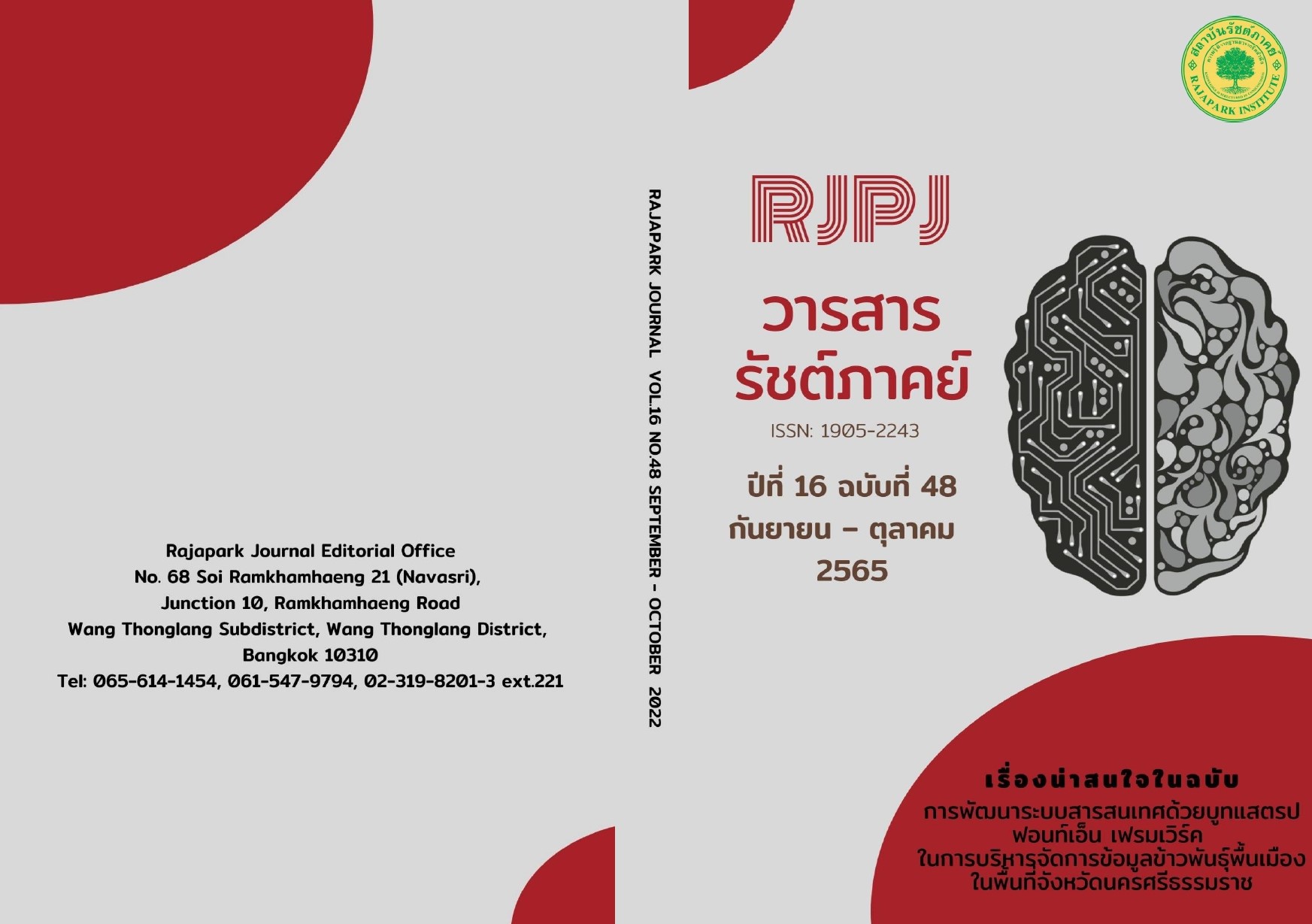The Factors Affecting Fertility Rate in Thai Female Reproductive Age
Main Article Content
Abstract
This article aimed to study the factors affecting fertility rate in Thai female reproductive age, the sample was Thai female fertility rate aged 15-49, aged 15-24, aged 25-34 and aged 35-49. They were selected by female labor force participation rate corresponding to the reproductive aged, male labor force participation rate, GDP growth rate and childcare availability the instrument for collecting data was the time series data for 21 years between 1998 to 2018 and applied multiple regression analysis to analyzed factor affecting fertility rate. Analysis data by descriptive statistics and content Analysis. The research results were found as follows; 1. Male labor force participation rate had statistical positive relationship to female fertility rate in all aged groups except female in 35-49 years of age. 2. Childcare availability and GDP growth had statistical negative relationship to fertility rate. 3. Female labor force participation rate had statistical negative relationship to fertility rate for female in working aged including female reproductive aged 25-34 and aged 35-49 respectively. This study indicated that an increasing in GDP annually which imply to the economic expansion associates to an increased in female labor force participation rate especially in working aged women reduce their fertility. However, nursery quality development refer to reduction number of children to caregiver being a factor to increase female fertility rate. An increasing of employment rate for male or maintain the male rate of employment was a positive measures to increase female fertility rate in Thailand.
Article Details

This work is licensed under a Creative Commons Attribution-NonCommercial-NoDerivatives 4.0 International License.
Views and opinions appearing in the Journal it is the responsibility of the author of the article, and does not constitute the view and responsibility of the editorial team.
References
Addati, L., Cassier, N., & Gilchrist, K. (2014). Maternity and Paternity at Work: Law and Practice Across the World. Technical Report. International Labour Organization (ILO).
Alatas, V., & Cameron, L. (2013). The Impact of Minimum Wages on Employment in a Low-Income Country: An Evaluation Using the Difference-in-Differences Approach. World Bank Research Working Paper 2985. Washington, DC: World Bank.
Aly, Y. H., & Quisi, I. A. (1996). “Determinants of Female Labor Force Participation in Kuwait: A Logit Analyses”, The Middle East Business and Economic Review.
Becker, G. (1985). Human Capital, Effort, and the Sexual Division of Labor. Journal of Labor Economics, S33-S58.
Boserup, E., Tan, S. F., & Toulmin, C. (2013). Woman’s Role in Economic Development. Routledge.
Buhari, D. & Mürsel, A. (2017). Female Labor Force Participation Rate and Economic Growth in the Framework of Kuznets Curve: Evidence from Turkey. Review of Economic & Business Studies, 10(1), 33-54.
Cramer, J. C. (1980). Fertility and Female Employment: Problems of Causal Direction. Am. Sociol. Rev, 45(2), 167–190.
Den, D. L. (2001). Work-family Arrangements in Organisations. A cross-National Study in The Netherlands, Italy, The United Kingdom and Sweden, Rosenberg Publishers, Amsterdam.
Dickey, D. A., & Fuller, W. A. (1981). Likelihood Ratio Statistics for Autoregressive Time Series with a Unit Root. Econometrica, 49, 1057-1072.
Fatima, A., & Humera S. (2009). Tracing out the U-Shape Relationship Between Female Labor Force Participation Rate and Economic Development for Pakistan. Applied Economics Research Centre, University of Karachi.
Grace, H. Y. L., & Sing, P. L. (2014). Childcare Availability, Fertility and Female Labor Force Participation in Japan. J. Japanese Int. Economies, 32, 71–85.
Hotz, V. J., Klerman, J. A., & Willis, R. J. (1997). The Economics of Fertility in Developed Countries. In: Rosenzweig, M.R., Stark, O. (Eds.), Handbook of Population and Family Economics. Elsevier, Amsterdam, pp.275-347.
Kanjanajitra, M., Sutthikasem, K., & Tadee, R. (2016). How to Build a Family: Balance the Life and Work of the New Generation. Nakhon Pathom: Institute for Population and Social Research Mahidol University.
Kreyenfeld, M. (2010). Uncertainties in Female Employment Careers and the Postponement of Parenthood in Germany. European Sociological Review, 26(3), 351-366.
Lechman E., & Kaur, H. (2015). Economic Growth and Female Labor Force Participation–Verifying the U-feminization Hypothesis. New Evidence for 162 Countries Over the Period 1990-2012. Economics and Sociology, 8(1), 246-257.
Mason, K. O., & Kuhlthau, K. (1992). The Perceived Impact of Child Care Costs on Women’s Labor Supply and Fertility. Demography 29(4), 523–543.
Mincer, J. (1963). Market Prices, Opportunity Costs and Income Effects. Measurement in Economics: Studies in Mathematical Economics in Honor of Yehuda Grunfeld (Stanford University Press, Stanford, CA).
Nakamura, J., & Ueda, A. (1999). On the Determinants of Career Interruption by Childbirth Among Married Women in Japan. J. Jpn. Int. Econ, 13, 73–89.
National Statistical Office. (2017). Important Conclusions Working for Women in Thailand 2016. Bureau of Economic and Social Statistics. National Statistical Office.
Rica, S., & Ferrero, M. D. (2003). The Effect of Fertility on Labor Force Participation: The Spanish Evidence. Span Econ Rev, 5(2), 153–172.
Sakiko, T., & Maricor, M. (2016). Female Labor Force Participation in Asia: Key Trends, Constraints, and Opportunities. Cornell University ILR School.
Samutchak, P. (2015). Low Birth and Decline in Thai Productivity. Productivity world, 20(114), 54-58.
Santarelli, E. (2011). Economic Resources and the First Child in Italy: A Focus on Income and Job Stability. Demographic Research, 25, 311.
Smith, L. L., & Tickamyer, A. (1978). Nonrecursive Models of Labor Force Participation, Fertility Behavior, and Sex Role Attitudes. Am. Sociol. Rev, 43, 541–557.
Stolzenberg, R. M., & Waite, L. J. (1984). Local Labor Markets, Children and Labor Force Participation of Wives. Demography, 21(2), 157–170.
Tansel, A. (2002). Economic Development and Female Labor force Participation in Turkey: Time-Series Evidence and Cross-Province Estimates. METU/ERC Working Paper No.02/3 Middle East Technical University Ankara, Turkey.
Vlasbom, J. D., & Schippers, J. J. (2004). Increases in Female Labor Force Participation in Europe: Similarities and Differences. Eur. J. Popul, 20, 375–392.
Willis, R. J. (1987). What Have we Learned from the Economics of the Family?. Am. Econ. Rev, 77(2), 68–81.
Willis, R. J. (1973). A New Approach to the Economic Theory of Fertility Behaviour. Journal of Political Economy, 81, S14-S64.


